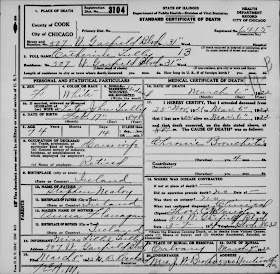A simple newspaper article, carefully kept for a lifetime among the personal papers of
Agnes Tully Stevens, spoke to her about the perils of immigration—more specifically, whipped up a yearning to uncover the truth about her maternal grandfather’s fate. Though undated and unsourced, this newspaper clipping meant a great deal to this woman whose mother never got to know her own immigrant father—an unsolved family mystery that kept the family’s memory of
Stephen Malloy alive long after his abrupt departure from his homeland in Ireland.
“Greatest Migration”
Immigrants And Horrors At Sea
LONDON (AP) – If you are American with an English, Irish, Scottish or Welsh name and have ancestors who came to the United States in 1800-75, you owe them a lot.
The debt is illustrated in two rooms of graphic history just opened at Britain’s Maritime Museum at Greenwich. It shows in stark reality how 7 ½ million immigrants crossed the Atlantic westward during the 19th century. “It was,” says Cmdr. W. E. May, deputy director of the museum, “The greatest migration man has ever made.” Many of the voyagers never made it to bear American and Canadian offspring. Most of the ships were unbelievably tiny, some just 50 feet long.
“Two hundred fifty-four passengers had been packed in the hold or steerage. Some had gone ashore when I got there. What I saw was – about 200 human beings, male and female, young and old and middle-aged, talking, singing, laughing, crying, eating, drinking, shaving, washing, some naked in bed and others dressing, handsome young women (some) and ugly old men, religious, irreligious.”
Appalling Conditions
Cmdr. May comments:
“In the early part of the great migration and especially during the Irish famine, conditions on shipboard were frequently appalling even by the standards of the 19th century.
“The records show that the deaths during the voyage were highest among the Irish, for they dragged themselves aboard suffering from malnutrition and some were dying as they sailed.”
Two photographs show the immigration ships Peter and Sarah. Both were built in 1809 and the picture was taken in 1859. Neither ship exceeded 50 feet in length.
Some of the ships were packed with humans to the point that it is difficult to understand how the crews were able to sail them.
“Here you can see records of 300 and 400 people sailing in one ship,” said Cmdr. May. “Yet the casualties were not as high as one might think.”
The descriptions at the exhibition – all in bold type – pull no punches.
“They emigrated for many reasons,” says one. “More than half of them were Irish, driven out by poverty, and the great famines of the 1840s. Many were Scots, forced by overpopulation and the policy of their landlords to escape conditions such as you see here.”
Below [in the exhibition but not included in the news report] are etchings of miserable huts, floors of damp earth, their roofs leaky.
Another etching depicts 25-30 persons jammed in huge carts leaving for ships to the New World. The description reads:
“People, poor, sometimes prosperous and even rich left in thousands, leaving their villages to a priest’s blessing to walk or travel in the carriers’ carts to the nearest seaport where a passage to North America was to be found. Between 1840 and 1860 nearly 150,000 a year, mostly Irish, sailed from Liverpool.”
Some of the ships went down with their passengers. Fire was the main hazard. There were terrible scenes when the Ocean Monarch burst into flames at sea. Others struck rocks and went down in storms. In 1947 [probably an error on the newspaper’s account, more likely meaning 1847] – admittedly a bad year – 17,500 immigrants, one in six of all who made the crossing that year, died on the voyage or shortly afterward.
























